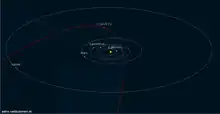 Near parabolic orbit has its perihelion above the northern ecliptic | |
| Discovery | |
|---|---|
| Discovered by | Asteroid Terrestrial-impact Last Alert System (ATLAS) |
| Orbital characteristics | |
| Epoch | 15 March 2020 (JD 2458924.06) |
| Number of observations | 993 |
| Aphelion | 669.1457±3.3432 AU |
| Perihelion | 0.837824 AU |
| Semi-major axis | 240.03275±0.16841 AU |
| Eccentricity | 0.996510 |
| Orbital period | 3718.90±3.914 yr |
| Inclination | 73.34814° |
| Last perihelion | 2020-Mar-15 |
| Earth MOID | 0.0829048 AU (12,402,380 km) |
| Jupiter MOID | 1.02611 AU |
| Comet total magnitude (M1) | 11.9±1.0 |
| Comet nuclear magnitude (M2) | 13.8±0.5 |
C/2019 Y1 (ATLAS) is a comet with a near-parabolic orbit discovered by the ATLAS survey on 16 December 2019. It passed perihelion on 15 March 2020 at 0.84 AU from the Sun.[1] Its orbit is very similar to C/1988 A1 (Liller), C/1996 Q1 (Tabur), C/2015 F3 (SWAN) and C/2023 V5 (Leonard), suggesting they may be fragments of a larger ancient comet.
Observations
The comet passed close to Earth in early May 2020. It was visible in the northern hemisphere sky in the spring of 2020.

1 week motion across the sky
References
External links
- TheSkyLive Archived 7 June 2020 at the Wayback Machine Comet C/2019 Y1 (ATLAS)
- astro.vanbuitenen.nl 2019Y1
- Universe Today 25 March 2020 by David Dickinson
This article is issued from Wikipedia. The text is licensed under Creative Commons - Attribution - Sharealike. Additional terms may apply for the media files.

.png.webp)